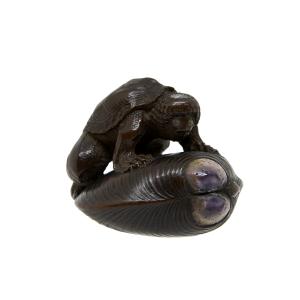The development and use of men's clothing complements called sagemono, 'hanging objects', is linked to clothing and fashion from the Edo period (1603-1868), in particular the use of a single style of dress, the kimono, common to all social classes. A long straight cut garment, without pockets and buttons, the kimono was worn by crossing the flaps one over the other and closed by means of a fabric belt called an obi. In the absence of pockets, small objects and consumables were kept in small containers hung on the obi belt. These were pill boxes (inrō), pipe holders (kiseruzutsu), handbags or tobacco containers (tabako-ire), small portable inkpots (yatate), purse bags (kinchaku) and perfume bottles (nioibin). The inrō, the most important sagemono, is a small case consisting of a wooden body covered and decorated with lacquer (urushi). Usually rectangular, the inrò is structured of a number of overlapping compartments, perfectly fitted to each other. The compartments must be able to open and close individually, without being separated: therefore they are held together by a silk cord (himo) inserted in holes drilled along the sides. A slip (ojime) allows you to loosen or tighten the cord as needed in order to open or seal the compartments. The netsuke is tied to the upper end of the cord and a pendant that secures the case to the obi belt, this pendant is also an ornamental element, made typically of carved ivory or wood. These miniature sculptures can represent the most disparate subjects: animals, small objects, human figures, creatures from folklore, divinities etc., with a particular preference for the graceful or eccentric.
Numerous schools of artists were founded (inrōshi) specializing in the manufacture of sophisticated inrō and netsuke. The range of netsuke and ojime with the inrò was an opportunity for collaboration between various craft shops: usually the three pieces referred to each other, forming a coherent whole in terms of material, decorative style or for the subject represented.
After the fall of the feudal regime in 1868, the adoption of western clothing led to the progressive disuse of the kimono and therefore also of the inrō and netsuke, which however continued to be produced to meet the demand of European and American collectors, fascinated by their tiny perfection.
Netsuke with kappa on a hamaguri shell

Netsuke with kappa on a hamaguri shell

Netsuke with kappa on a hamaguri shell

Netsuke with kappa on a hamaguri shell





